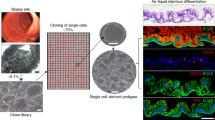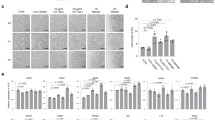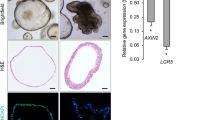Abstract
A novel method for generating nontransformed human intestinal primary epithelial cell (HIPEC) lines in an in vitro culture system is reported here. Although several groups have reported the development of nontransformed intestinal epithelial cells (IEC) lines (Deveney et al, 1996; Latella et al, 1996; Pang et al, 1996; Perreault and Beaulieu, 1998), it still had been difficult to find an optimal condition to generate a pure population of nontransformed IEC in long-term cultures. It was hypothesized that an appropriate growth factor/cytokine milieu that would mimic the physiological microenvironment might favor the survival of the isolated cells and might play a critical role in epithelial cell growth. To test this hypothesis, isolated progenitor/crypt cells were cultured in collagen-coated petri dishes in the presence of mucosal tissue-derived growth factor containing culture supernatants (14–18 hours) and a combination of hormonal supplements. Cell attachment and growth was observed within 24 hours and confluent monolayers were seen between 7 and 12 days. Immunofluorescence staining and flow cytometric analysis of the cells demonstrated positive staining with anti-cytokeratin-18 antibody confirming their epithelial origin. The reproducibility of the method has been confirmed by establishing a number of HIPEC lines from various segments of the gastrointestinal tract. This novel method of HIPEC line generation, which maximizes the similarity of the ex vivo culture system to in vivo conditions, will serve as a valuable tool for the establishment of a large number of HIPEC lines (intestinal epithelial cell bank) and for subsequent use in studies of the immunological/physiological epithelial function in the intestine.
Similar content being viewed by others
Main
Resected surgical specimens were brought to the laboratory within 30 minutes of surgery and rinsed several times in antibiotic containing PBS. The mucosa was dissected and cut into small pieces as described previously(Panja et al, 1995). A portion of the tissue pieces was cultured (250 mg/ml) overnight in F-12 medium to generate culture supernatants containing autologous growth factor(s)/cytokines (AGF-Sup) that would potentially mimic the cytokine milieu of the mucosal site. The remaining portion of the tissue was processed for isolation of surface and crypt epithelial cells by using dispase (1 mg/ml) as a dissociating agent as was recently described (Panja et al, 1998).
The role of AGF-Sup in supporting epithelial cell survival was assessed by culturing freshly isolated crypt or surface epithelial cells with either 10% AGF-Sup or FCS-containing medium for 24 hours. Cells with the AGF-containing medium clearly showed greater viability than did cells with the FCS-containing medium (Table 1). This difference in cell viability was not related to the serum concentration in FCS-containing medium as, in a separate series of experiments, lowering the FCS concentration further decreased the viability, and, in some cases, addition of AGF with the FCS improved the viability (data not shown). This suggested that mucosal tissue-derived growth factors have a role in supporting epithelial cell survival and may regulate potential cell growth in vitro.
We next cultured the isolated crypt/progenitor epithelial cells in F-12 medium (1×106 cells/ml) containing 10% AGF-Sup that would allow cells to be in an environment (in terms of cytokine/growth factor milieu) that closely approximates the tissue they inhabited before isolation. In the cases of HIPEC lines generated from biopsy samples, allogeneic tissue explant culture supernatant was used to support growth. The medium was supplemented with epidermal growth factor (EGF) (5 ng/ml), transferrin (500 μg/ml), insulin (500 μg/ml), hydrocortisone (100 μg/ml), and retinoic acid (5 μg/ml), and hereafter referred to as “HIPEC medium.” Cells were plated in a petri dish coated with collagen-IV (Collaborative Research, Bedford, Massachusetts). After 24 hours, the medium was removed, unattached cells were removed by washing, and fresh medium was added to the culture. At confluence, cells were dissociated and subcultured at a 1:3 split ratio. Growing cells in medium free of serum minimized the possibility of potential contamination with fibroblasts. Fibroblasts usually require a high concentration of serum in the culture medium.
Morphologically, the HIPEC lines appeared to be of polygonal shape with irregular cytoplasmic processes and a cobblestone appearance (Fig. 1A). Epithelial origin of HIPEC lines was ascertained by staining these cells with an anti-cytokeratin-18 monoclonal antibody (Sigma, St. Louis, Missouri). As can be seen in Figure 1B, 100% of HIPEC cells were positive for cytokeratin. An isotype control antibody did not react with HIPECs (not shown).
Morphological appearance and phenotype of the human intestinal primary epithelial cell (HIPEC) monolayer. A, Phase contrast photomicrograph of a semiconfluent colonic HIPEC monolayer shows typical epithelial morphology with polygonal shape and cobblestone appearance. B, Confocal microscopic examination of a HIPEC line for its ability to express cytokeratin. Cells were grown directly on cover slips. After permeabilization and fixation, cells were stained with an anti-cytokeratin-18 or a negative control antibody (not shown). Expression of cytokeratin-18 was seen in all cells present in the HIPEC monolayer.
The HIPEC monolayers are easily detachable from the plastic surface and can be subjected to multiple passages (up to 24). A portion of each HIPEC line from each passage was kept frozen in multiple aliquots in liquid nitrogen, and their capacity to grow in culture after thawing was tested. Defrosted cells from each passage were capable of growing in secondary cultures.
To further evaluate the actual involvement of the autologous growth factors on HIPEC growth, we examined the effect of AGF on cell proliferation by culturing the cells in medium with or without AGF-Sup. As can be seen in Figure 2, addition of AGF in culture significantly enhanced HIPEC cell proliferation in a dose-dependent fashion. These results clearly demonstrate a beneficial effect of the mucosal tissue-derived growth factors in HIPEC culture.
Effect of AGF-Sup on HIPEC growth. HIPECs were cultured with various dilutions of AGF-Sup in 96-well plate (2K cells/well) in triplicate for 24 hours. Cell proliferation was assessed by 3H-thymidine uptake assay. Consistent with the cell viability data (Table 1), cell proliferation was enhanced by addition of AGF-Sup in a dose-dependent fashion. This figure is representative of three separate experiments.
It is worthy of mention that, using the technology described here, we have established paired HIPEC lines from actively inflamed and uninflamed areas of inflammatory bowel disease (IBD) (both ulcerative colitis [UC] and Crohn’s disease [CD] from resected specimens as well as biopsy samples) epithelium from the same individual. Several paired HIPEC lines from the actual tumor site and its normal counter part in the same individual’s colonic epithelium have also been established in our laboratory. The availability of paired HIPEC lines of this type will allow the undertaking of studies directed at identifying cellular, molecular, and genetic differences between HIPEC lines generated from normal versus diseased epithelium, eg, inflamed versus uninflamed and cancerous versus noncancerous. Such studies are currently in progress in our laboratory.
Thus, eventually, HIPEC lines may serve as an important tool for epithelial cell biology, mucosal immunity, colon cancer, and IBD research. Also, the ability to grow nontransformed cells in HIPEC medium will provide the opportunity to design gene therapy or tissue transplantation/reconstruction that is tailored to each individual patient's needs.
References
Deveney CW, Rand-Luby L, Rutten MJ, Luttropp CA, Fowler WM, Land J, Meichsner CL, Farahmand M, Sheppard BC, Crass RA, and Deveney KE (1996). Establishment of human colonic epithelial cells in long-term culture. J Surg Res 64: 161–169.
Latella G, Fonti R, Caprilli R, Marcheggiano A, Magliocca F, Das KM, Gambus G, and Sambuy Y (1996). Characterization of the mucins produced by normal human colonocytes in primary culture. Int J Colorectal Dis 11: 76–83.
Pang G, Buret A, O’Loughlin E, Smith A ., Batey R, and Clancy R (1996). Immunologic, functional, and morphological characterization of three new human small intestinal epithelial cell lines. Gastroenterology 111: 8–18.
Panja A, Goldberg S, Eckmann L, Krishen P, and Mayer L (1998). The regulation and functional consequence of proinflammatory cytokine binding on human intestinal epithelial cells. J Immunol 161: 3675–3684.
Panja A, Siden E, and Mayer L (1995). Synthesis and regulation of accessory/proinflammatory cytokines by intestinal epithelial cells. Clin Exp Immunol 100: 298–305.
Perreault N and Beaulieu JF (1998). Primary cultures of fully differentiated and pure human intestinal epithelial cells. Exp Cell Res 245: 34–42.
Author information
Authors and Affiliations
Corresponding author
Rights and permissions
About this article
Cite this article
Panja, A. A Novel Method for the Establishment of a Pure Population of Nontransformed Human Intestinal Primary Epithelial Cell (HIPEC) Lines in Long Term Culture. Lab Invest 80, 1473–1475 (2000). https://doi.org/10.1038/labinvest.3780154
Received:
Published:
Issue Date:
DOI: https://doi.org/10.1038/labinvest.3780154
This article is cited by
-
Newly established tumourigenic primary human colon cancer cell lines are sensitive to TRAIL-induced apoptosis in vitro and in vivo
British Journal of Cancer (2007)
-
Transformed immortalized gastric epithelial cells by virulence factor CagA of Helicobacter pylori through Erk mitogen-activated protein kinase pathway
Oncogene (2005)
-
Novel colon cancer cell lines leading to better understanding of the diversity of respective primary cancers
Oncogene (2002)





